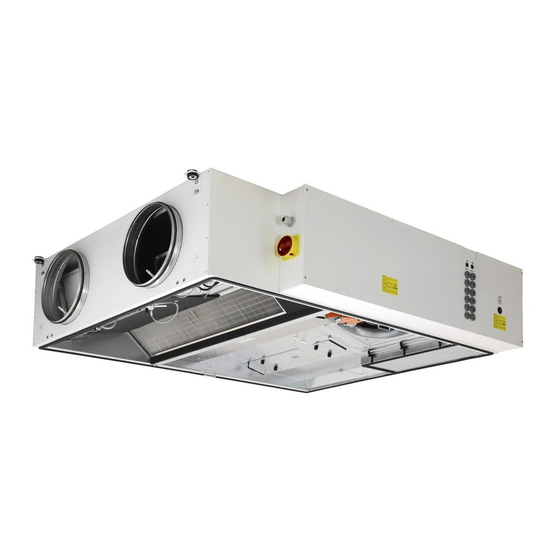
Salda RIS EKO 3.0 700 PE 3.0 Mounting And Installation Instruction
Source: salda.lt/en, vetter-lufttechnik.de
Table of Contents
Advertisement
Quick Links
Advertisement
Table of Contents

Summarization of Contents
4. INFORMATION ABOUT THE PRODUCT
4.1. DESCRIPTION
Provides a general overview of the air handling unit and its primary functions.
4.2. DIMENSIONS AND WEIGHT
Details the physical size and weight specifications for different product models.
4.3. TECHNICAL DATA
Lists key technical specifications like voltage, power, speed, and filter classifications.
4.4. OPERATING CONDITIONS
Outlines the environmental parameters required for safe and effective unit operation.
4.5. STANDARD PACKAGE OF COMPONENTS
Lists the standard components included with the unit across various models.
4.6. DESCRIPTION OF COMPONENTS
Explains the role and function of each major internal component of the air handling unit.
5. INSTALLATION
5.1. RECEPTION OF GOODS
Instructions for inspecting the unit upon delivery and reporting any transport damage.
5.2. TRANSPORTATION AND STORAGE
Guidelines for safely handling, transporting, and storing the unit before installation.
5.3. UNPACKING
Procedures for safely removing the unit and its accessories from the packaging.
5.4. PIPING AND INSTRUMENTATION DIAGRAM
Visual diagram illustrating system connections and component layout for installation.
5.5. MOUNTING
Covers unit placement, positioning requirements, and ceiling mounting considerations.
5.6. CONNECTION OF THE AIR DUCT
Guidance on correctly connecting air ducts, considering airflow direction and noise reduction.
5.7. CONNECTION OF THE UNIT TO ELECTRIC NETWORK
Critical safety and technical information for connecting the unit to the electrical supply.
5.8. START-UP RECOMMENDATIONS
Essential checks and procedures to follow before the unit's initial startup.
6. MAINTENANCE
6.1. SAFETY INSTRUCTION
Crucial safety precautions to observe before performing any maintenance tasks on the unit.
6.2. GENERAL RECOMMENDATIONS FOR THE MAINTENANCE OF VENTILATION SYSTE
General advice on regular maintenance schedules and procedures for optimal system function.
6.3. COVER OPENING
Steps for safely opening the unit's covers to access internal components for maintenance.
6.4. FILTERS MAINTENANCE
Instructions for cleaning or replacing air filters to maintain airflow and air quality.
6.5. FANS MAINTENANCE
Guidance on inspecting, cleaning, and maintaining the unit's fans for proper operation.
6.6. HEAT EXCHANGER MAINTENANCE
Procedures for cleaning the heat exchanger to ensure its efficiency and longevity.
6.7. HEATER MAINTENANCE
Information regarding the maintenance and thermal protection of the unit's electrical heater.
6.8. CONTROL BOARD MAINTENANCE
Steps for accessing and performing maintenance on the unit's electronic control board.
7. CONTROL
7.1. DEVICE CONTROL
Overview of methods for controlling the unit, including remote panels and network interfaces.
7.2. DEVICE FUNCTIONS
Explains how unit configuration and selected interface affect operational functions and settings.
8. ACCESSORIES
8.1. CONNECTION OF ACCESSORIES
Guidelines for connecting various optional accessories like sensors, dampers, and control panels.
12. WARRANTY
12.1. LIMITED WARRANTY COUPON
Details the warranty terms, conditions, and the process for claiming warranty service.















Need help?
Do you have a question about the RIS EKO 3.0 700 PE 3.0 and is the answer not in the manual?
Questions and answers